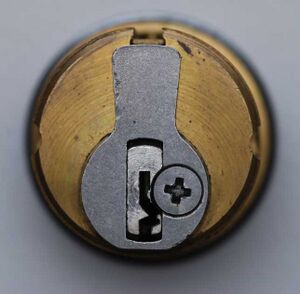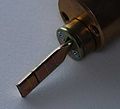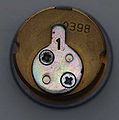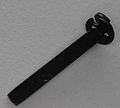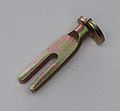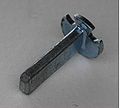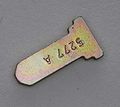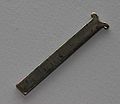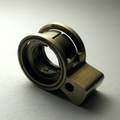Actuator: Difference between revisions
From Lockwiki
Jump to navigationJump to search
mNo edit summary |
m (added image of cam from a euro profile cylinder) |
||
| (3 intermediate revisions by one other user not shown) | |||
| Line 1: | Line 1: | ||
=Actuator= | =Actuator= | ||
[[File:Actuator Cam01.jpg|thumb|right|text-top|A pin-tumbler actuator connected to the lock.]] | |||
:''See [[Cam lock]] for information on actuators used as locking bolts.'' | |||
The '''actuator''' (or '''cam''', '''tail''', '''tailpiece''') is an extension, usually connected to the [[plug]] of the [[lock]], that activates or deactivates the mechanical locking component, such as the cam or [[bolt]]. | |||
When the actuator is used as the primary bolt mechanism the lock is called a [[cam lock]]. Attacks against the lock actuator are a method of [[bypass]]. | |||
__TOC__ | |||
== Types of actuators == | |||
In [[Pin_tumbler |pin-tumbler]], [[wafer]], and [[Disc_detainer |disc-detainer]] locks: | |||
* The actuator is connected to the [[plug]] and interfaces with components that control the bolt. | |||
In rotary [[combination]] locks: | |||
* The actuator is the ''drive cam'' that controls the wheel pack and catches the lever nose to retract the bolt. | |||
In [[lever]] locks: | |||
* The actuator is the ''bolt talon'' or ''drive lever'' that connects directly to the bolt. | |||
== Gallery == <!-- Please keep this as varied as possible! --> | |||
<div align="center"><gallery> | |||
File:Actuator Cam02.jpg | |||
File:Actuator Cam03.jpg | |||
File:Actuator Cam04.jpg | |||
File:Actuator Cam05.jpg | |||
File:Actuator Cam06.jpg | |||
File:Actuator Cam07.jpg | |||
File:Actuator Cam08.jpg | |||
File:Actuator Cam09.jpg | |||
File:Actuator Cam10.jpg | |||
File:IKON_TK5_cam-Reinder.png | |||
</gallery></div> | |||
== See also == | == See also == | ||
| Line 14: | Line 44: | ||
* [[Bolt]] | * [[Bolt]] | ||
* [[Bypass]] | * [[Bypass]] | ||
[[Category:Locks]] | [[Category:Locks]] | ||
Latest revision as of 13:51, 13 January 2023
Actuator
- See Cam lock for information on actuators used as locking bolts.
The actuator (or cam, tail, tailpiece) is an extension, usually connected to the plug of the lock, that activates or deactivates the mechanical locking component, such as the cam or bolt.
When the actuator is used as the primary bolt mechanism the lock is called a cam lock. Attacks against the lock actuator are a method of bypass.
Types of actuators
In pin-tumbler, wafer, and disc-detainer locks:
- The actuator is connected to the plug and interfaces with components that control the bolt.
In rotary combination locks:
- The actuator is the drive cam that controls the wheel pack and catches the lever nose to retract the bolt.
In lever locks:
- The actuator is the bolt talon or drive lever that connects directly to the bolt.
